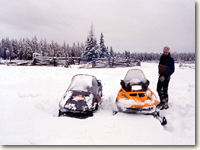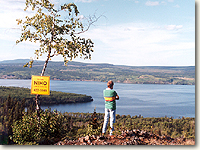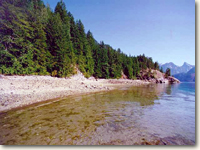Rudy’s Outdoor Tips
Anyone can walk into the wilderness and walk out again in two weeks. How you fare in those two weeks depends upon how prepared you are. The English used to go on safaris for months into the South African wilderness and would have 30-50 porters with them, and when camp was set they would have a table, white linen cloth, crystal glasses and a bottle of wine, and good meals. This is what we called "prepared".
If you go to an outdoors store, buy a great back pack and all the amenities such as sleeping bags, dry foods and cooking utensils and just about everything else you need to be comfortable in a tent, and then go hiking on a well used trail, such as the West Coast Trail, (following the signs), setting up your camp in a designated spot, you will avoid getting lost or into trouble. This is being prepared.
Most people get into trouble and/or get lost when not prepared. I have searched for a number of people who have become lost. (Just about all of them were not prepared). It is surprising how many people get lost by just leaving their car and heading into the bush a short distance away, only to get completely turned around and be lost within a matter of minutes, or by just leaving a main hiking trail for a short distance.
The following useful tips are some that I have learned over the years in the bush.
 I have used a number of methods to be prepared in case of trouble, such as small pouches on a belt holding a number of essential items, a fanny pack holding necessities, a small backpack and a vest. Over the past 35 years I have been in and out of vehicles, helicopters and planes looking at properties, and even though I don’t anticipate running into trouble, I have on a couple of occasions just done that. Consequently, I have tried a number of methods and found the best solution is a vest, which I always wear in and out of my vehicle when in the bush. The reason I wear a vest is that I never take it off. You can remove a fanny pack or backpack (you might store it in the back of a car or plane) and then you might end up forgetting it.
I have used a number of methods to be prepared in case of trouble, such as small pouches on a belt holding a number of essential items, a fanny pack holding necessities, a small backpack and a vest. Over the past 35 years I have been in and out of vehicles, helicopters and planes looking at properties, and even though I don’t anticipate running into trouble, I have on a couple of occasions just done that. Consequently, I have tried a number of methods and found the best solution is a vest, which I always wear in and out of my vehicle when in the bush. The reason I wear a vest is that I never take it off. You can remove a fanny pack or backpack (you might store it in the back of a car or plane) and then you might end up forgetting it.
The vest I use is very lightweight with many pockets and in each pocket I have stored
specific items such as the following, which are great for short-term survival:
A compass with mirror. (A mirror is handy for looking at any facial injuries, e.g. a twig in the eye, or cut from a branch. On one occasion, I had to put two stitches in my head because of a wound that would not stop bleeding).
Lighter & Fire Starter. I use two BIC lighters and a couple of fire starters in a zip lock bag. I have tried everything under the sun, but a good old BIC always seems to work. Fire starters, which can be bought at army surplus stores, are little tablets that light quickly and give a hot flame for a long time. Barbecue starters, cut into squares, will also serve the purpose.
Baseball cap - you lose most of your body heat from your head. In rainy weather wear a waterproof Gortex hat to stay dry. Carry water with it. Sit on it in wet ground. Hold your head down in thick brush or spider webs. Of course, it shields you from the sun.
Mini flashlight. Using a small flashlight in light underbrush will get you out of a tight situation. Carry extra batteries.
Beef jerky, raisins, assorted dry fruit, and a couple granola bars.
Sardines. With, or without a piece of bread, I find it gives me more nourishment for its size then anything else. It’s light, not too big, the top comes off easily without having to use an opener and the flat can fits into the vest pocket. Afterwards, it makes into a miniature frying pan. If you carry a small piece of a wire, a handle can be added and you can then boil ¾ of a cup of water at one time.
Tang - I always carry a small package of tang. It has brought me out of many emergency situations. For example on one occasion my son and I could not find any game because of a blizzard in the mountains, and we lived on tang, by sticking our finger into the package and licking it off. We lived this way for 3 days without any other food and it gave us enough energy to carry on and finally shoot a moose for food.
Garbage bags - these are very important items for survival as they have many uses, such as:
- For a raincoat, by cutting a holes for your head and arms, and then putting it over your clothes to make a fairly good raincoat.
- For warmth you could take a garbage bag again and cut holes for head and arms and use it as inner clothing over a T-shirt this will create a lot of "short-term" warmth. Because this will cause you to sweat (you do not not want to sweat), it is recommended for a short time only. If you are really desperate you could add grass or straw underneath the garbage bag as this will give you an insulated vest.
- A garbage bag can be used for building a lean-to, by opening the bag up and putting it on top for a roof and on the sides for a waterproof shelter, which will also act as a windbreaker.
- A mattress can be made by taking the ends of spruce boughs (about the first 6 inches), then breaking them off and filling into a garbage bag. Remember, cold comes up from the ground therefore you have to keep some kind of a barrier between yourself and the cold ground.
- If you get a hole in your boot you can wrap garbage bags around your feet and put them inside your boots to create a waterproof barrier.
- You can create a good waterproof hat, which will hold in the heat. Put a garbage bag over your head, tie it with a shoelace and let it drape down your back.
- Spread out a garbage bag overnight and moisture will form. This puddle of water will be small in summer but bigger in the fall.
 Three different size Ziploc bags - they are small and easy to put into a vest or even your pocket. If it starts raining, a large Ziploc bag will hold air photos and maps and a smaller size will hold lighters, matches and anything you need to keep dry but most important you can collect water and carry it with you.
Three different size Ziploc bags - they are small and easy to put into a vest or even your pocket. If it starts raining, a large Ziploc bag will hold air photos and maps and a smaller size will hold lighters, matches and anything you need to keep dry but most important you can collect water and carry it with you.
Four leather shoelaces. I found a leather shoelace could fix many things, e.g. a tear in your coat or your pants…It is one of the easiest ways to hang things on your pants or your vest. A leather shoelace will fix a snowshoe better than anything I have ever tried. If you carry your coat and it gets too hot, it is easy to tie both ends around the end of your coat and loop it over your shoulder and create a sling.
Balloons If you become lost or injured, blow them up, tie them to a string and leave in an open area - the bright colours can be spotted from a plane, helicopter or from a distant hill. Balloons also make miniature water containers.
Waterproof pen Great for leaving messages and writing notes on trees.
On my belt I carry:
A folding clasp, good quality knife.
A leatherman tool. Also known as the multi-tool, this is a must and should be one of your most important pieces of equipment. It is small, fits on your belt and has many uses. Different brands have different uses but generally, it has a knife, needle-nose pliers, cutters, three sizes of common screws, bottle opener, ruler, punch, file and Phillips-head screwdriver, serrated edge knife, wire stripper and wood and bone saw. Great for every camper and RV’er.
A Bowie axe. (only if there is a good possibility of spending the night under a tree) If in very heavy brush, I use this as a machete.
A hip chain. This is an amazingly accurate measuring device small enough to fit on the side of your belt. One end can be tied to a tree and when you start walking, this chain of thread will keep calculating how far you have gone, in feet or metres, and of course, it will lead you back in the same direction if you are worried about getting lost.
Other essential items:
A light rain poncho.
A folding hat.
Two miniature flares.
Small first aid kit with suture.
Toilet paper.
A dozen nails.
A piece of tinfoil.
A piece of snare wire.
Fish hooks some flies and some line.
A 100-foot length of nylon rope.
Orange ribbon
Electricians tape
A small mixture of seasoning salt and pepper.
 COMMON SENSE TIPS:
COMMON SENSE TIPS:
When you first get our of your vehicle determine with your compass which way the road is running - e.g. northeast/southwest - and then when you enter the bush, watch where the sun is in relationship to your body. If you walk into the bush and the sun is on your right shoulder then you know when you walk back out of the bush the sun has to be on your left shoulder. This gives you some idea, which is north and south. Remember that the sun rises in east and sets in the west.
Landmarks:
Mountains, Hills. Look at landmarks before you leave. Find a high mountain, or even a hill, and keep it in sight to determine where you are. Look at your map before you leave to find where mountains and hills are.
Waterways. A great direction finder. Water comes from the snow packs in the mountains, then forms creeks which go into the lakes and rivers, which drain into the major rivers, which flow into the ocean.
Transportation Systems. Look at your map and establish transportation systems. Where are the hillways, roads, railroads, pipelines and hydro lines?
I am lost - now what?
Common sense is thinking things out, not rushing, and always looking around you into the environment, remembering where you were and just locking in the information you have learned. Even the most experienced bushmen sometimes make mistakes and get lost. I, too, have been lost a number of times.
I recommend the following:
When you realize you are lost, the first thing that you do is find a comfortable place to sit down, think and analyze your situation. Try and figure out where you think you are. In your mind retrace your steps where you came from to where you are.
The first thing you should do is to determine where north, south, east and west are. The easiest way to do this is by using your compass. Take out your compass and determine north and south and lay a stick in a north south direction or mark it in the ground. If you don’t have a compass look at the sun and determine where you are approximately. You know that around noon the sun should be the highest, so determine approximately where north is. (The sun rises in the east and sets in the west).
If you don’t have a compass and it is a cloudy day you have to go by the hints given by the land. You know that the southern slope gets the most sun. This is where the game feeds in the wintertime. Everything is brighter on the southern side than on the northern side. In dense bush you will find moss growing on the north side of a tree. Hills will have more grass and less snow in wintertime. There are lots of little hints that will tell you where south is by the terrain. Creeks and rivers - remember that British Columbia has the Rocky Mountains on one side and the coast range on the other side. The Fraser River and the Thompson River run down into Vancouver. The Skeena River and the Bulkley River run out into Prince Rupert. All rivers and creeks run into these major systems. It should give you an indication of which way the water system is draining and will give you some idea where north and south is.
Once you have determined where north/south is, try to remember where you came from. If you have a map locate yourself approximately. Analyze which is the easiest way out. And this is not always going back to where your vehicle is parked. Sometimes you are closer to a main road and it is better going to that than circling back through the bush. Once on the main road you can possibly get a ride back to your vehicle or walk.
Listen for sounds - cars on highways, railroads, human voices. Sound carries a long way in the bush, so stop and listen.
Never start running, always walk at a good steady pace. Do not panic. Once you panic and start walking fast or running you will sweat and could get a mild hypothermia. Stumbling, falling off a cliff, or getting a twig in your eye are other possible hazards.
Half an hour before dark be prepared to set up a camp. Find a shelter or build a lean-to and be prepared to spend the night.
Light a fire and make it large and as quick as possible using the fire kit that you carry with you at all times. The two most important things out in the bush are warmth and water. You can live for 30 days without food but if you go into hypothermia from lack of warmth, or you do not have any water, you won’t survive very long at all. Once you get your fire lit you must, before dark, gather a lot of firewood, grabbing anything you can. Gather an enormous pile of wood. If you think you have enough for one night, double it, that way you will have enough for sure. Remember that once your fire is lit and you have good coals, any log will burn, even a wet green one. You never want to let your fire die out in the middle of the night. There is nothing more important than getting a fire going. Continue to work your way out the next morning.
If you do spend the night and still have not determined direction, look into the sky. Look for the North Star, which is at the end of the big dipper. Again take a stick and aim the stick towards the North Star and let it drop so the next morning you will know which way north is.
Always carry a map of the area. The best thing, of course, is an air photo. If you do not have one, use a detailed contour map. As a last resort, draw a map yourself of the area before you leave your vehicle.
Contact Information: #200 - 313 Sixth Street, New Westminster, BC V3L 3A7 CANADA
Telephone: 604-606-7900 | Email: [email protected]
Copyright © 2012 Niho Land & Cattle Company. All rights reserved. | Privacy Policy | Terms of Use | Webmaster

